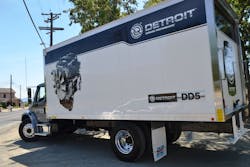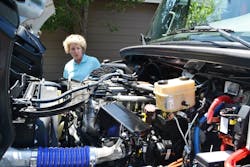Can a 4-cylinder engine effectively and efficiently do the job in medium-duty conventional truck applications? Daimler Trucks North America is convinced a 5-liter diesel makes sense, and—following the Daimler platform’s success in Europe—the market-leading truck maker is confident enough to kick off its entry into medium-duty engines on this side of the Atlantic with the Detroit DD5. Based on our 20-mile test drive through the heart of Napa’s wine country, the platform certainly has potential.
Granted, a Class 6 Freightliner M2 106 with a 20-ft. box wouldn’t be most folks’ first choice of vehicle for cruising the famed Silverado Trail on a warm, sunny California afternoon—but truck editors aren’t most folks. And we did our best not to let the scenery distract us from the job at hand: putting the DD5 through its paces.
(As an aside, we’re not reviewing the M2 106 here—but Fleet Owner Editor Jim Mele and American Trucker Editor Kevin Jones were immediately impressed by the truck’s turning radius as we pulled away from the staging area and made the U-turn across a narrow side road. Likewise, we had no problem backing at an awkward angle to position the truck for some photos at the end of the drive.)
Merging onto a fast four-lane with the four-banger (230 HP, 660 lb-ft torque) was as easy as putting the pedal to the floor—and then letting it up well before the end of a short on-ramp. At cruising speed, the noise-dampening touches clearly work: conversation was as easy as a chat in a full-size pickup. Running at 60 mph with the traffic, another punch to the pedal easily got us around a slow-moving RV and back in time to let a much faster convertible continue on its merry way.
We were also impressed by the engine braking. With the toggle on the dash set to high, the system brought the truck to crawl so quickly the brakes didn’t need to be applied until we reached the traffic light at the end of an off-ramp. (At 50-60 mph, we really couldn’t get a feel for the less aggressive low engine-brake setting.)
And while we can make allowances for seats that aren’t what we might like (a Class 8 highway tractor is an unfair comparison, but we’re spoiled), we did notice more vibration than we expected in the medium-duty truck when the M2 stopped at several lights along the route. But in stop-and-go driving, the engine—paired with an Allison 2500 RDS transmission—provided a smooth experience.
We would’ve liked to have had the same truck equipped with the alternative power plant, a 6-cylinder Cummins ISB, for direct side-by-side (or ride-by-ride) comparison but, based on a “what have you done for me lately?” standard, we have to say the DD5 works as advertised: It’s an entirely capable engine with an obvious fuel economy benefit. The question, for customers, is whether or not specs make a good fit. For DTNA's initial target market, P&D, GM for marketing and strategy Kary Schaefer put it simply.
“Why a 4-cylinder? Why not,” Schaefer said. "We’re able to do the job and then some, and that’s exactly what the customers are expecting. It makes for a better engine.”
Asked and answered.
Of course, the market provides the ultimate review. But if the global corporate clout of Daimler is behind a project, chances are the concept is sound. Ultimately, however, buyers—not company strategists—will make the call.
About the Author
Kevin Jones 1
Editor
Kevin has served as editor-in-chief of Trailer/Body Builders magazine since 2017—just the third editor in the magazine’s 60 years. He is also editorial director for Endeavor Business Media’s Commercial Vehicle group, which includes FleetOwner, Bulk Transporter, Refrigerated Transporter, American Trucker, and Fleet Maintenance magazines and websites.

